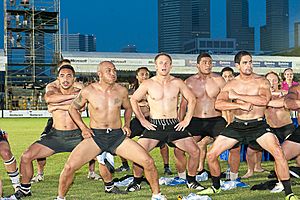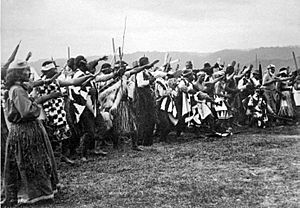Haka facts for kids

The haka is a special traditional dance, war cry, or challenge from the Māori culture in New Zealand. It's performed by a group of people with strong, energetic movements and loud shouts. Imagine powerful stomping, shouting, and big actions!
Originally, warriors would perform haka before a battle. This was to show how strong and skilled they were, hoping to scare their enemies. But haka are also used for many other reasons today. They can welcome important guests, celebrate big achievements, or honor people at funerals. Many schools in New Zealand have groups that perform haka, called kapa haka.
A haka uses many parts of the body to tell its story:
- Voice: Chanting and shouting.
- Feet: Stomping and leaping.
- Hands: Slapping, waving, and clapping.
- Eyes: Rolling them to show strong feelings.
- Tongue: Poking it out as a sign of challenge or strength.
There are many different types of haka, and each one tells a unique story. The most famous haka is called Ka Mate. You might have seen it performed by many New Zealand sports teams before their games. Another well-known haka is 'Kapo O Pango', which is performed by New Zealand's national rugby union team, known as the All Blacks.
Contents
What is the History of Haka?
Many people know about haka because of the All Blacks rugby team and the New Zealand rugby league team. However, this has sometimes led to misunderstandings about what haka truly is.
Most haka are performed by men. But there are also some haka that are mainly performed by women. One famous example is the "Ka Panapana" haka from the Ngāti Porou tribe.
Today, new haka are even created for women and children to perform. Haka are used for many different events, like welcoming important visitors or celebrating big moments.
War haka, called peruperu, were first performed by warriors before a fight. They showed their strength and skill to scare the other side. Now, haka are a big part of official welcome ceremonies for important visitors or leaders from other countries. They help make the occasion feel very special and important.
During a haka performance, people use many actions. This includes making strong facial expressions, like showing the whites of their eyes and poking out their tongues. They also do many powerful body movements, such as slapping their hands against their bodies and stomping their feet. Besides chanted words, they use different cries and grunts. You can think of a haka like a symphony where different parts of the body are like musical instruments. The hands, arms, legs, feet, voice, eyes, tongue, and the whole body work together. They show feelings like courage, anger, joy, or whatever emotion fits the event.
Different Types of Haka
There are several kinds of haka, including whakatu waewae, tutu ngarahu, and peruperu. The peruperu haka involves big leaps where the legs are pulled up under the body. A long time ago, the peruperu was performed before a battle. It was meant to ask for help from the god of war and to scare the enemy. This haka included fierce facial expressions, sticking out the tongue, bulging eyes, grunts, cries, and waving weapons. If the haka wasn't performed perfectly together, it was seen as a bad sign for the battle ahead. Sometimes, warriors would go into battle wearing only a woven flax belt around their waist.
The tutu ngarahu also involves jumping, but it's a side-to-side jump. In the whakatu waewae haka, there is no jumping at all. Another type of haka performed without weapons is the ngeri. Its main goal was to mentally prepare the warriors and make them feel brave. The movements in a ngeri are very free, allowing each performer to show their own feelings. Manawa wera haka were usually performed at funerals or other events related to death. Like the ngeri, they were done without weapons and had very few planned movements.
The most famous haka is "Ka Mate". It was created by Te Rauparaha, a war leader of the Ngāti Toa tribe. The "Ka Mate" haka is a ceremonial haka. It tells the story of how Te Rauparaha cleverly tricked his enemies. It can be seen as a celebration of life winning over death.
The Mythology Behind Haka
According to Māori mythology, the sun god, Tama-nui-te-rā, had two wives: Hine-raumati, the Summer Maid, and Hine-takurua, the Winter Maid. The haka is said to have started with the arrival of Hine-raumati. On hot, still days, her presence was shown by a shimmering, wavy look in the air. This shimmering was the haka of Tāne-rore, who was the son of Hine-raumati and Tama-nui-te-rā.
Related Pages
Images for kids
See also
 In Spanish: Haka para niños
In Spanish: Haka para niños






